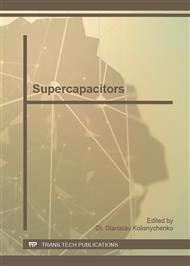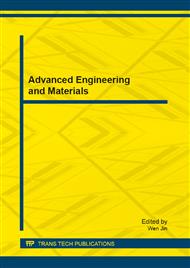[1]
J.S. Huang, B G. Sumpter,V. Meunier, A Universal Model for Nanoporous Carbon Supercapacitors Applicable to Diverse Pore Regimes, Carbon Materials, and Electrolytes,J. Chem. Eur. J. 2008, 14, 6614-6626.
DOI: 10.1002/chem.200800639
Google Scholar
[2]
A. Balducci, R. Dugas, P. Taberna, et al. Passerini. High temperature carbon-carbon supercapacitor using ionic liquid as electrolyte.,J. Power Sources 165 (2007) 922.
DOI: 10.1016/j.jpowsour.2006.12.048
Google Scholar
[3]
R. Kotz , M. Carlen, Principles and applications of electrochemical capacitors,J. Electrochimica Acta 45 (2000) 2483-2498.
DOI: 10.1016/s0013-4686(00)00354-6
Google Scholar
[4]
Amini, N.; Aguey-Zinsou, K. F.; Guo, Z. X, Processing of strong and highly conductive carbon foams as electrode[J]. Carbon 2011, 49, 3857.
DOI: 10.1016/j.carbon.2011.05.022
Google Scholar
[5]
S.U. Kim, K. H. Lee, Carbon nanofiber composites for the electrodes of electrochemical capacitors, J. Chemical Physics Letters 400 (2004) 253-257.
DOI: 10.1016/j.cplett.2004.10.124
Google Scholar
[6]
J.B. Wang, X.Q. Yang, D.C. Wu , et al. The porous structures of activated carbon aerogels and their effects on electrochemical performance,J. Journal of Power Sources 185 (2008) 589- 594.
DOI: 10.1016/j.jpowsour.2008.06.070
Google Scholar
[7]
Q. XIE, X.L. ZHANG,Q.R. CHEN, et al. Influence of surface modification by nitric acid on the dispersion of copper nitrate in activated carbon,J. NEW CARBON MATERIALS, 2013, 18, 3.
Google Scholar
[8]
N.P. Liu; J Shen.; D. Liu, Activated high specific surface area carbon aerogels for EDLCs, Microporous Mesoporous Materials. 2012, 10. 1016/j. micromeso. 2012. 09. 009.
DOI: 10.1016/j.micromeso.2012.09.009
Google Scholar
[9]
D.H. LONG, J. ZHANG,J.H. YANG, Preparation and microstructure control of carbon aerogels produced using m-cresol mediated sol-gel polymerization of phenol and furfural, J. New Carbon Materials, 2008, 23(2): 165-170.
DOI: 10.1016/s1872-5805(08)60020-7
Google Scholar
[10]
B.S. SHEN, W.J. FENG,J.W. LANG, Nitric Acid Modification of Graphene Nanosheets Prepared by Arc-Discharge Method and Their Enhanced Electrochemical Properties,J. Acta Phys. -Chim. Sin. 2012, 28 (7), 1726-1732.
Google Scholar
[11]
D.W. WANG , F. LI , M. LIU , Improved capacitance 0f SBA 一 15 templated mesoporous carbons after modification with ntric acid oxidation,J. NEW CARBON MATERIALS, 2007, 24, 4.
DOI: 10.1016/s1872-5805(08)60002-5
Google Scholar



